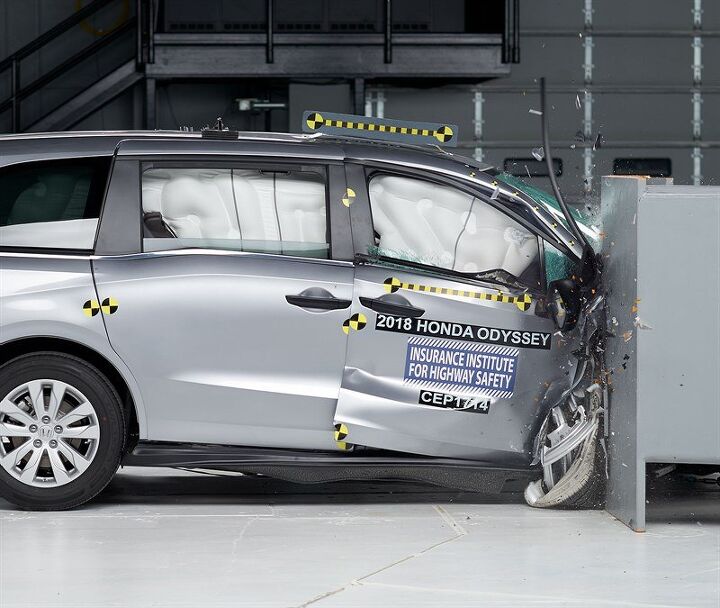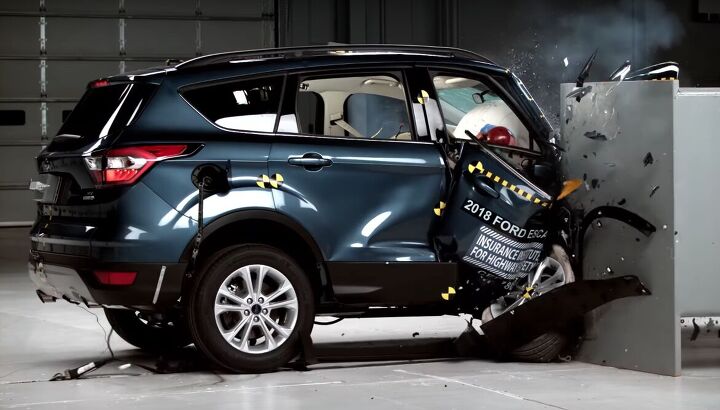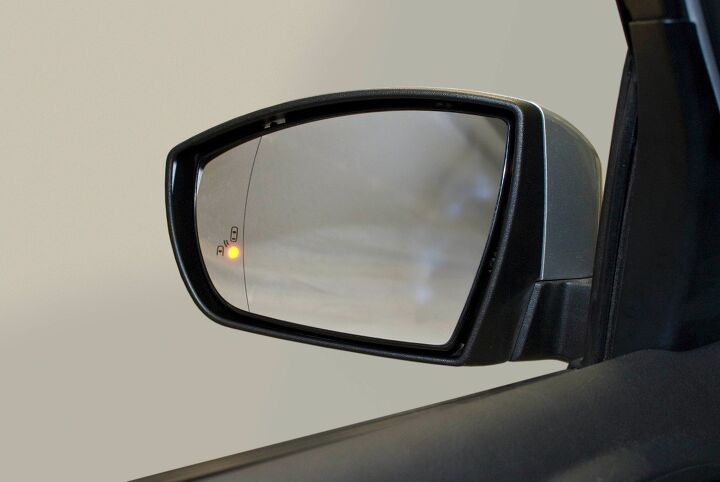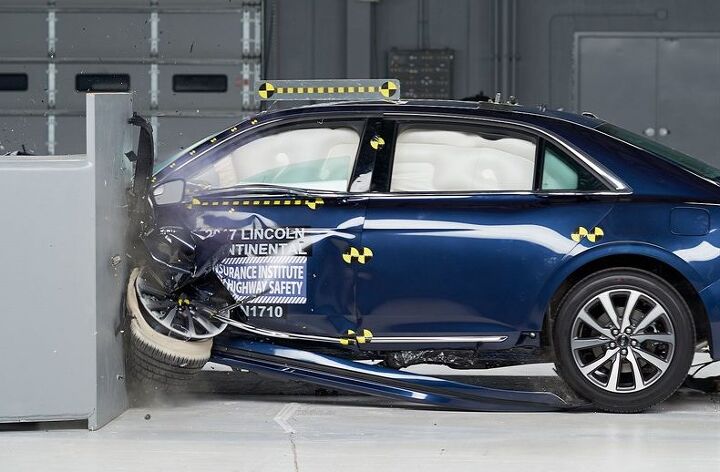#InsuranceInstituteForHighwaySafety
The 57 Models That Received IIHS Safety Awards for 2019 (Spoiler: There Aren't Many Americans)
Despite perpetually raising the bar on what constitutes automotive safety, the Insurance Institute for Highway Safety just gilded nearly five dozen models with Top Safety Pick or Top Safety Pick Plus awards. The metrics, which now hinge largely on a vehicle possessing crash avoidance systems and superior headlamps, require the highest rating available in passenger-side protection during its small overlap front crash to get the coveted Plus decoration — which 30 vehicles qualified for in the initial 2019 model year evaluation.
Hyundai, which managed to walk away with the most awards, swiftly issued a press release to humblebrag that it bested the competition two years running. Considering how well the Koreans performed, it was likely warranted. Automakers absolutely love this kind of stuff, so you can expect to see future references made to the awards in the next batch of car commercials.
IIHS Recommends Putting Your Teen Behind the Wheel of the Largest Vehicle Possible
Assuming you’re the sort of parent who’s willing and able to buy your child their first vehicle, you’ve probably made safety your top priority. While you could purchase a new vehicle with all the latest self-preservation tech, teens have a habit of scratching up cars. If you buy them an old clunker, they’ll learn a valuable lesson about the importance of auto maintenance but won’t be as protected when they crash into something — which they’re statistically more likely to do.
The Insurance Institute for Highway Safety recently updated its list of recommended vehicles for teens, promoting the “bigger is better” mentality. It claims an older, larger used vehicle is often a safer choice when compared to a newer small vehicle that costs roughly the same. While the institute’s suggestion makes sense, it’s also one step removed from recommending putting teenagers in armored personnel carriers.
Automakers Ready to Rock When New NHTSA Headlight Rules Arrive
The National Highway Traffic Safety Administration announced earlier this month that it was willing to considering changing the rules that govern automobile headlights. Now in a comment period before its official review, the proposal would permit automakers to install and enable adaptive driving beam headlights on new cars sold in the United States. While some automakers are preparing themselves for the change, most have been ready for ages.
One one hand, this proposed change should help lousy drivers from burning out your retinas on a lonesome country road. But, by the same token, you may no longer have the delicious opportunity to blast them with the brights once they’re within a few feet of your car to let them know to lower those damned high beams.
Just kidding, that would be illegal. Federal mandates require all drivers to dim their headlights when approaching within 500 feet of an oncoming vehicle or when approaching a vehicle less than 300 feet ahead. Of course, nobody we know has ever witnessed this law being actively enforced — even though it’s probably as dangerous as moderate speeding infractions. Regardless, it’ll gradually become a non-issue if the rules change.
Higher Risk: Study Claims States That Legalized Marijuana Have More Traffic Accidents
The Insurance Institute for Highway Safety and the Highway Loss Data Institute announced Thursday that auto crashes in states with legalized recreational marijuana have increased 6 percent. Both groups will be on hand at the Combating Alcohol-and Drug-Impaired Driving summit at IIHS’ Vehicle Research Center in Ruckersville, Virginia to present two studies on the issue. Perfect timing, considering Canada just became the second country to legalize the substance and support for decriminalization continues to grow in the United States.
Of course, things are rarely so simple. While the IIHS and HLDI remain confident in their research, the National Highway Traffic Safety Administration claimed marijuana use was unlikely to contribute to traffic mishaps in any meaningful way back in 2015. And that’s just for starters. There is so much conflicting information on this issue, it’ll make your head spin harder than the most savage bong rip of your life, bro.
Honda Odyssey Reigns Supreme in Latest Minivan Crash Test
You don’t need a family to own a minivan, it just helps avoid a series of awkward follow-up questions. However, regardless of whether you’re riding with your complete progeny or your only friend in the world, you probably hope your vehicle has your back in the event of an accident.
The Insurance Institute for Highway Safety’s small overlap crash test separated the wheat from the automotive chaff ever since its introduction in 2012. The test imagines what happens when the front corner of a vehicle collides with another vehicle or an stationary object, focusing an immense amount of energy on a small area of the automobile. It’s a worst-case scenario for the structural integrity of a model and makes for a great viewing experience, as it really does a number on the test car.
Despite fielding a rather pathetic number of vehicles, the minivan segment performed pretty well in the IIHS passenger-side small overlap front crash test on the whole. However, while no outright deathtraps revealed themselves, the group still saw some mixed results.
Deadly Design: SUV Proliferation a Contributing Factor in Pedestrian Deaths, Study Says
Sport-utility vehicles and crossovers are great for families who want maximized interior volume and a sense of security, but the high-riding vehicles are a double-edged sword. In addition to being less economical than a sedan with a similar footprint, the design doesn’t bode well for pedestrians. In fact, the proliferation of SUVs may be the largest contributing factor to pedestrian fatalities right now. From 2009 to 2016, fatal single-vehicle crashes involving utility vehicles increased by 81 percent.
That’s disconcerting, considering the number of pedestrian killed on U.S. roads declined by 20 percent since 1975, hitting an all-time low in 2009. However, in 2016 the death toll had climbed back up to the highest levels since 1990. The Governors Highway Safety Association estimated nearly 6,000 people were fatally struck by vehicles last year, with around 4,700 of those deaths occurring in urban or suburban areas. Conversely, those same environments only saw 2,959 deaths in 2009.
The increase in fatalities cannot be contributed entirely to the design of SUVs. Distracted driving, encouraged by smart phones and increasingly complicated infotainment systems, has undoubtedly pressed the issue. But, when a strike does occur, the shape of a vehicle still plays an enormous factor.
Driving Aids Allow Motorists to Tune Out, NTSB Wants Automakers to Fix It
Driving aids are touted as next-level safety tech, but they’re also a bit of a double-edged sword. While accident avoidance technology can apply the brakes before you’ve even thought of it, mitigate your following distance, and keep your car in the appropriate lane, it also lulls you into a false sense of security.
Numerous members of the our staff have experienced this first hand, including yours truly. The incident usually plays out a few minutes after testing adaptive cruise control or lane assist. Things are progressing smoothly, then someone moves into your lane and the car goes into crisis mode — causing you to ruin your undergarments. You don’t even have to be caught off guard for it to be a jarring experience, and it’s not difficult to imagine an inexperienced, inattentive, or easily panicked driver making the situation much worse.
Lane keeping also has its foibles. Confusing road markings or snowy road conditions can really throw it for a loop. But the problem is its entire existence serves to allow motorists to take a more passive role while driving. So what happens when it fails to function properly? In ideal circumstances, you endure a moderate scare before taking more direct command of your vehicle. But, in a worst case scenario, you just went off road or collided with an object at highway speeds.
Latest IIHS Crash Tests: Throwing Small Crossovers at the Wall, Seeing What Sticks
The Insurance Institute for Highway Safety (IIHS) has released new ratings for seven small utility vehicles. For the most part, the pint-sized crossovers performed amicably. However, none of the models were worthy of the group’s coveted “Top Safety Pick Plus” award due to subpar headlamp performance, while a couple of models were found structurally deficient after being confronted with the dreaded small overlap crash test.
Ford’s Escape received an overall poor rating and came away from the test with the worst structural deformation within the group. Senior IIHS research engineer Becky Muller noted that Ford reinforced the diver’s side of the vehicle for the 2017 model year but negated extending that courtesy to passengers.
“Disparities like this one are why we decided to formally rate the passenger side in the small overlap test after five years of evaluating only the driver side,” she explained. “Manufacturers shouldn’t shortchange protection for front-seat passengers.”
The IIHS is Hoping For a Bright Future When It Comes to Headlights
Even though headlights have evolved from uniform circles illuminating the roadway in largely the same way to diverse units that look and function very differently, their overall performance has improved immensely. Nobody is going to jump from a 1955 DeSoto to a 2018 Dodge and think “Wow, these headlamps are just terrible.”
However, the International Institute for Highway Safety has been on a two-year mission to make modern headlights look bad and there are two possible explanations as to why. Either the IIHS genuinely believes the current offerings from manufacturers are unsafe, or it’s trying to promote competition within the industry to produce a better bulb. The truth, as usual, is likely somewhere in the middle.
The IIHS' Updated Criteria Absolutely Devastated Its Top Safety Pick List
While the Insurance Institute for Highway Safety has steadily upgraded its standards over the last two years, the effort hasn’t been without casualties. In a new effort to improve headlight safety and impact protection, the organization has changed its testing criteria for 2018 to include both illumination and passenger-side frontal impacts.
Unfortunately, including these aspects in its final verdict of how safe a vehicle is has removed numerous models from consideration for 2018’s Top Safety Pick+ awards. Last year, 38 vehicles qualified for the safety plus appointment. This year, however, the grand total only came to 15 models — most wearing badges from Hyundai Motor Group and Subaru.
The IIHS makes no apologies for keeping so many cars from receiving top honors. Instead, it claims it was time to heap higher expectations on automakers for items like visibility and passenger safety.
Which Segments Incur the Largest (or Smallest) Insurance Losses?
Insurance may be one of the greatest scams ever pulled on the general public, but it’s a very necessary evil. Right around the time the automobile became popular, people starting crashing them into things. By the 1920s, individual states began requiring drivers to purchase insurance — creating a pooled solution that covered at-fault drivers for damages they might be unable to pay otherwise.
However, not all drivers crash and not all vehicles incur the same costs when they take or deliver a beating. Collision losses might be astronomical for high-end sports cars but comparably moderate for midsize pickup trucks. The Insurance Institute for Highway Safety and Highway Loss Data Institute recently compiled the loss averages for hundreds of models, grouping them by segments, to establish how lightly-used autos stack up against each other.
Smaller Pickups Outperformed the Big Boys in IIHS Overlap Crash Test
The Insurance Institute for Highway Safety recently ran eight pickups through the small overlap front crash test, which replicates one of the most infamous and deadly of accident types — one where the front corner of a vehicle collides with another vehicle or object. The segment, which the IIHS called “small pickups,” could easily be categorized as midsize. But, with no smaller options currently available in the domestic market, their terminology works well enough.
So, how did the smaller pickups stack up when hurled toward a concrete pylon at 40 miles an hour? A little better than you might expect.
If we were absolutely forced to drive into a brick wall, we’d probably prefer to be seated in a full-size truck — specifically the Ford F-150 SuperCab. But the junior pickup group wasn’t a segment full of deathtraps. In fact, they suffered less structural deformation overall and posed less risk of injury to the lower leg region when compared to their full-size brethren. There were exceptions, however.
Lane Departure Warnings, Blind Spot Alerts (Probably) Reducing Crashes: Study
Lane departure alerts and blind spot monitoring systems can significantly reduce crashes if consumers use the features, according to two recent studies by the Insurance Institute for Highway Safety. While this information falls into the no-brainer category, rarely do we get specific metrics on these particular technologies.
“This is the first evidence that lane departure warning is working to prevent crashes of passenger vehicles on U.S. roads,” explained Jessica Cicchino, IIHS vice president for research. “Given the large number of fatal crashes that involve unintentional lane departures, technology aimed at preventing them has the potential to save a lot of lives.”
These Large Cars Offer the Most Luxurious Crash Experience
Like the rest of North America’s passenger car market, full-size sedan sales are waning. While luxury vehicles haven’t taken quite the same hit as more affordable models, big cars are not in fashion for 2017. However, some buyers still prefer the distinction and mass that only a full-size automobile can provide. They want a luxurious, low-slung ride and, if possible, an equally elegant crash experience.
While big cars tend to perform better in accidents than the majority of their petite contemporaries, very few vehicles do well in the small overlap crash test. The Insurance Institute for Highway Safety recently took six of its favorite picks from the segment to evaluate side impact crashes, roof strength, protection from head restraints, moderate overlap front crashes, and the dreaded small overlap front impact.
“This group of large cars includes some with stellar ratings, but our small overlap front test remains a hurdle for some vehicles,” explained David Zuby, IIHS executive vice president and chief research officer.
Study Links Legalized Recreational Marijuana to Increased Crash Rates
Tragically, the Insurance Institute for Highway Safety has correlated the legalization of recreational marijuana use with more automobile accidents. Pot smoking in Colorado, Oregon and Washington seems to have resulted in collision frequencies roughly 3 percent higher than what would have been expected without legalization, according to a recent analysis from the Highway Loss Data Institute.
While this certainly isn’t an endorsement for de-legalizing recreational marijuana use, it is a reminder to stay off the roads if you’re having your head changed. Operating a motor vehicle while baked can get you into a sticky-icky situation, and nobody wants you having a green out on the expressway. That said, risks associated with driving under the influence of marijuana are much less cut-and-dried than alcohol.
This is largely due to how difficult it is for researchers to test marijuana. Despite its growing legalization, marijuana is classified by the Drug Enforcement Agency as a Schedule 1 drug, and subject to the highest level of restriction. Researchers need approval from their institution and apply for a license from the DEA before conducting a study. The government also has only so much pot to dole out for research purposes and gives the majority of it to the National Institute on Drug Abuse — fair and balanced testing of whether or not getting high while driving is safe is a little lower on NIDA’s list of priorities. In this instance, the same might be suggested of the IIHS.






























Recent Comments